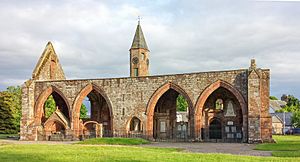Fortrose Cathedral facts for kids
Quick facts for kids Fortrose Cathedral |
|
|---|---|
| Church of Saint Peter and Saint Boniface of Fortrose | |

Ruins of the cathedral
|
|
| 57°34′51″N 4°07′50″W / 57.580885°N 4.130495°W | |
| Country | Scotland |
| Denomination | Church of Scotland |
| Previous denomination | Roman Catholic |
| History | |
| Founded | c. 1200 |
| Founder(s) | unknown |
| Dedication | Saint Peter |
| Cult(s) present | Curetán ("Boniface") |
| Past bishop(s) | John Lesley |
| Architecture | |
| Architectural type | Late Gothic |
| Administration | |
| Diocese | Ross |
Fortrose Cathedral was a very important church in medieval Scotland. It was the main church, called the cathedra, for the Bishop of Ross. A bishop is a high-ranking church leader. The cathedral was located in the Highland region of Scotland, not far from the city of Inverness.
It's thought that the first main church for the Ross area was in a place called Rosemarkie. But by the 1200s, the church officials, known as canons, moved a short distance away. They settled in the area now known as Fortrose or Chanonry. Early on, the cathedral was looked after by a group of monks called Céli Dé, also known as culdees.
Contents
Church Officials and Income
The cathedral had many different officials, like a dean, an archdeacon, and a treasurer. Each of these officials received income from certain churches. This income was called a prebend. There were twenty-one prebends in total, linked to the income of thirty-one churches.
After the church's leadership structure was reorganized in the 1250s, the Bishop of Ross received income from the churches of Nigg and Tarbat. Other officials, like the archdeacon and dean, also had specific churches that provided their income. For example, the dean received income from Ardersier and Kilmuir.
Some wealthy areas, like Rosemarkie and Cromarty, had their income divided among four main officials: the dean, chanter, chancellor, and treasurer. Also, some churches in the western parts of Scotland, like Applecross and Kintail, shared their income among all the church leaders. By the early 1300s, the head of Kinloss Abbey, an important monastery, became a permanent member of the Fortrose cathedral leadership. This was because he was in charge of the church in Avoch.
What the Cathedral Looked Like
Fortrose Cathedral was mostly built using red sandstone. Today, only two parts of the original building are still standing. These are the chapter house, which was a meeting room for the church leaders, and the south aisle of the nave. The nave is the main part of the church where people sit.
In 1873, archaeologists dug up the area around the ruins. They found the outlines of the rest of the cathedral complex. It seems the building started around the early to mid-1200s. It was a long, rectangular shape with a tower in the northwest corner. There was also a chapter house and a sacristy (a room for church items) north of the choir, which is where the singers stood.
The southeastern chapel, aisle, and porch were added later, in the late 1300s. These were paid for by Euphemia I, Countess of Ross. These parts of Fortrose Cathedral look similar to parts of Elgin Cathedral from the same time. This might be because the bishop of Fortrose, Alexander de Kylwos, had previously worked at Elgin Cathedral.
Important People Buried Here
The south aisle of the cathedral has two separate chapels, and several important people were buried there. The chapel on the eastern side is believed to be the burial place of Countess Euphemia and Bishop Robert Cairncross. The tomb in the western chapel is thought to belong to Bishop John Fraser.
Alexander of Islay, who was both the Earl of Ross and the Lord of the Isles, was also buried in the cathedral. However, the exact spot of his grave is not known. On the ceiling of the western chapel, there are two special carvings called heraldic bosses. These carvings show the symbols of Earl Alexander and Bishop John Bulloch.
According to a historian named Alexander Mackenzie, many early leaders of the Clan Munro were buried at Fortrose Cathedral. It was the family's burial place for over 400 years. Some of the Munro chiefs mentioned as being buried there include Robert Munro (died 1164), Donald Munro (died 1192), and Hugh Munro, 9th Baron of Foulis (died 1425).
The Cathedral's Decline
After the Scottish Reformation in the 1500s, when Scotland changed its main religion, Fortrose Cathedral continued to be used as a local church. However, it began to fall apart. In June 1572, Lord Ruthven was even allowed to take the lead from the roof to sell it.
The building slowly became more ruined in the late 1500s and early 1600s. Even so, the sacristy and chapter house were still used for local meetings by officials in the 1700s. Like many other former cathedrals in Scotland, its grounds continued to be used as a graveyard. The Scottish government took over looking after the ruins in 1851. Today, Fortrose Cathedral is a scheduled monument, which means it's a protected historic site.
Images for kids




